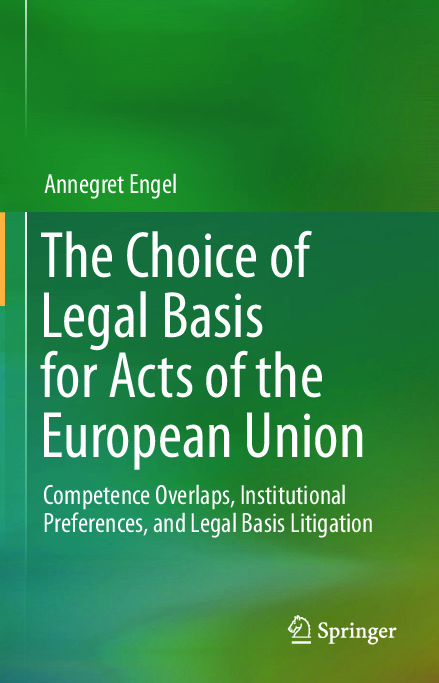File #2346: "2018_Book_TheChoiceOfLegalBasisForActsOf.pdf"
Testo
1|Dedication|5
1|Preface|6
1|Acknowledgements|8
1|List of Abbreviations|12
1|Contents|9
1|Chapter 1: Introduction|14
2|1.1 In General|14
3|1.1.1 The Structure of Legal Bases|14
3|1.1.2 The Conundrum of Legal Basis Litigation|15
3|1.1.3 The Pillars of the European Union|16
2|1.2 About This Book|18
3|1.2.1 The Aims of the Book|18
3|1.2.2 Chapter Overview|19
2|References|20
1|Chapter 2: Conflicts Between the Union’s Different Types of Competences|22
2|2.1 Introduction|22
2|2.2 Competence Categories|23
3|2.2.1 Double-Classification of Competence Types|24
3|2.2.2 The Development of the ‘Centre of Gravity’ Theory|26
3|2.2.3 Judicial Review of Competence Conflicts Post-Lisbon|29
2|2.3 Horizontal Competences and the Principle of Lex Specialis Derogat Legi Generali|32
3|2.3.1 Harmonising the Internal Market with Articles 114/115 TFEU: An Antiquated ‘One-Fits-It-All’ Approach?|33
3|2.3.2 Article 352 TFEU: A Subsidiary Provision|40
2|2.4 Supranational Versus Intergovernmental Competences|44
3|2.4.1 Retained Distinctiveness in the Area of Freedom, Security and Justice|45
4|2.4.1.1 The Nature and Scope of AFSJ Competences|46
4|2.4.1.2 Legislative Procedures|47
3|2.4.2 Safeguarding Member States’ Competences?|49
4|2.4.2.1 Internal Versus External Competences|50
4|2.4.2.2 Harmonisation Versus Flexibility|55
2|2.5 Conclusion|58
2|References|59
1|Chapter 3: The Choice of Legal Instrument: A Choice of Legal Basis?|63
2|3.1 Introduction|63
2|3.2 Legislative Acts: Article 288 TFEU|64
3|3.2.1 The Distinction Between Regulations, Directives, and Decisions|65
3|3.2.2 The Alignment of Legal Effects|68
2|3.3 Non-Legislative Acts: Articles 290 and 291 TFEU|70
3|3.3.1 Delegated Versus Implementing Acts|71
4|3.3.1.1 Institutional Preferences|72
4|3.3.1.2 General Criteria of Legal Basis Litigation|74
3|3.3.2 Supplementing Versus Amending Delegation|76
3|3.3.3 Misuse of Implementing Power|78
2|3.4 Legislative Versus Non-Legislative Acts|80
2|3.5 Conclusion|82
2|References|83
1|Chapter 4: The Choice of Legislative Procedure: A Matter of Institutional Preference?|86
2|4.1 Introduction|86
2|4.2 Procedural Differences|87
3|4.2.1 Voting Requirements|87
3|4.2.2 The Institutional Balance|89
2|4.3 Special Versus Ordinary Legislative Procedure|90
3|4.3.1 Subjective Versus Objective Factors|91
3|4.3.2 Single Versus Dual Legal Basis|94
3|4.3.3 The Democracy Maximising Rationale|98
2|4.4 Legislative Versus Non-Legislative Procedure|101
3|4.4.1 An Intergovernmental Institutional Balance|102
3|4.4.2 The Commission’s Discretionary Powers Versus Parliamentary Control|103
2|4.5 Conclusion|106
2|References|107
1|Chapter 5: The Sui Generis Nature of External Competences|110
2|5.1 Introduction|110
2|5.2 International Agreements|111
3|5.2.1 Classical Versus Cross-Pillar Mixity|112
3|5.2.2 Turning Mixity Into Exclusivity|115
4|5.2.2.1 The Marrakesh Treaty|116
4|5.2.2.2 The EU-Singapore Free Trade Agreement|117
4|5.2.2.3 Evaluation|119
2|5.3 The Structure of Legal Bases Under the Area of Common Foreign and Security Policy|121
3|5.3.1 The Scope and Nature of the Competence|121
3|5.3.2 Legal Instruments|124
3|5.3.3 Decision-Making Procedures|125
4|5.3.3.1 The Institutional Balance|126
4|5.3.3.2 Voting Requirements|127
2|5.4 Article 40 TEU: From ‘One-Way Street’ to Non-Affection in Both Directions|128
3|5.4.1 ECOWAS Revisited|131
3|5.4.2 The Application of General Criteria of Legal Basis Litigation|134
2|5.5 The Unity Theory: A Self-Fulfilling Prophecy?|137
3|5.5.1 Legal Personality|139
3|5.5.2 Bridging the Gap: The High Representative|139
2|5.6 Conclusion|142
2|References|143
1|Chapter 6: Conclusions|147
2|6.1 General Findings|147
3|6.1.1 Competence Overlaps|147
3|6.1.2 Divergent Institutional Preferences|149
3|6.1.3 General Criteria and Paradoxes of Legal Basis Litigation|149
2|6.2 Recommendations|152
2|References|152
1|Preface|6
1|Acknowledgements|8
1|List of Abbreviations|12
1|Contents|9
1|Chapter 1: Introduction|14
2|1.1 In General|14
3|1.1.1 The Structure of Legal Bases|14
3|1.1.2 The Conundrum of Legal Basis Litigation|15
3|1.1.3 The Pillars of the European Union|16
2|1.2 About This Book|18
3|1.2.1 The Aims of the Book|18
3|1.2.2 Chapter Overview|19
2|References|20
1|Chapter 2: Conflicts Between the Union’s Different Types of Competences|22
2|2.1 Introduction|22
2|2.2 Competence Categories|23
3|2.2.1 Double-Classification of Competence Types|24
3|2.2.2 The Development of the ‘Centre of Gravity’ Theory|26
3|2.2.3 Judicial Review of Competence Conflicts Post-Lisbon|29
2|2.3 Horizontal Competences and the Principle of Lex Specialis Derogat Legi Generali|32
3|2.3.1 Harmonising the Internal Market with Articles 114/115 TFEU: An Antiquated ‘One-Fits-It-All’ Approach?|33
3|2.3.2 Article 352 TFEU: A Subsidiary Provision|40
2|2.4 Supranational Versus Intergovernmental Competences|44
3|2.4.1 Retained Distinctiveness in the Area of Freedom, Security and Justice|45
4|2.4.1.1 The Nature and Scope of AFSJ Competences|46
4|2.4.1.2 Legislative Procedures|47
3|2.4.2 Safeguarding Member States’ Competences?|49
4|2.4.2.1 Internal Versus External Competences|50
4|2.4.2.2 Harmonisation Versus Flexibility|55
2|2.5 Conclusion|58
2|References|59
1|Chapter 3: The Choice of Legal Instrument: A Choice of Legal Basis?|63
2|3.1 Introduction|63
2|3.2 Legislative Acts: Article 288 TFEU|64
3|3.2.1 The Distinction Between Regulations, Directives, and Decisions|65
3|3.2.2 The Alignment of Legal Effects|68
2|3.3 Non-Legislative Acts: Articles 290 and 291 TFEU|70
3|3.3.1 Delegated Versus Implementing Acts|71
4|3.3.1.1 Institutional Preferences|72
4|3.3.1.2 General Criteria of Legal Basis Litigation|74
3|3.3.2 Supplementing Versus Amending Delegation|76
3|3.3.3 Misuse of Implementing Power|78
2|3.4 Legislative Versus Non-Legislative Acts|80
2|3.5 Conclusion|82
2|References|83
1|Chapter 4: The Choice of Legislative Procedure: A Matter of Institutional Preference?|86
2|4.1 Introduction|86
2|4.2 Procedural Differences|87
3|4.2.1 Voting Requirements|87
3|4.2.2 The Institutional Balance|89
2|4.3 Special Versus Ordinary Legislative Procedure|90
3|4.3.1 Subjective Versus Objective Factors|91
3|4.3.2 Single Versus Dual Legal Basis|94
3|4.3.3 The Democracy Maximising Rationale|98
2|4.4 Legislative Versus Non-Legislative Procedure|101
3|4.4.1 An Intergovernmental Institutional Balance|102
3|4.4.2 The Commission’s Discretionary Powers Versus Parliamentary Control|103
2|4.5 Conclusion|106
2|References|107
1|Chapter 5: The Sui Generis Nature of External Competences|110
2|5.1 Introduction|110
2|5.2 International Agreements|111
3|5.2.1 Classical Versus Cross-Pillar Mixity|112
3|5.2.2 Turning Mixity Into Exclusivity|115
4|5.2.2.1 The Marrakesh Treaty|116
4|5.2.2.2 The EU-Singapore Free Trade Agreement|117
4|5.2.2.3 Evaluation|119
2|5.3 The Structure of Legal Bases Under the Area of Common Foreign and Security Policy|121
3|5.3.1 The Scope and Nature of the Competence|121
3|5.3.2 Legal Instruments|124
3|5.3.3 Decision-Making Procedures|125
4|5.3.3.1 The Institutional Balance|126
4|5.3.3.2 Voting Requirements|127
2|5.4 Article 40 TEU: From ‘One-Way Street’ to Non-Affection in Both Directions|128
3|5.4.1 ECOWAS Revisited|131
3|5.4.2 The Application of General Criteria of Legal Basis Litigation|134
2|5.5 The Unity Theory: A Self-Fulfilling Prophecy?|137
3|5.5.1 Legal Personality|139
3|5.5.2 Bridging the Gap: The High Representative|139
2|5.6 Conclusion|142
2|References|143
1|Chapter 6: Conclusions|147
2|6.1 General Findings|147
3|6.1.1 Competence Overlaps|147
3|6.1.2 Divergent Institutional Preferences|149
3|6.1.3 General Criteria and Paradoxes of Legal Basis Litigation|149
2|6.2 Recommendations|152
2|References|152

